
Systematic Sampling Methods for Customer Feedback
Customer surveys are powerful tools for uncovering insights that shape better products, services, and experiences.
But there’s a catch: your results are only as good as your sample.
If you collect feedback from the wrong group, your conclusions may be misleading, or worse, completely useless.
That’s where systematic sampling comes in.
Systematic random sampling offers a structured, consistent way to select participants so you don’t waste time or budget while still ensuring fair representation.
By choosing people at fixed intervals from an ordered list, you can quickly build a reliable sample without the complexity of pure random selection.
In this guide, we’ll cover the meaning of systematic sampling, how the method works, when it makes sense to use, its pros and cons, and practical ways to apply it in customer feedback surveys.
What Is Systematic Sampling?
Before going deeper, let’s first understand what systematic sampling means and how it works.
Systematic Sampling Definition and Key Concept
To define systematic sampling, it is a probability sampling method where you select every k-th individual from an ordered list, starting at a randomly chosen point.
This ensures that your sample is spread evenly across the entire population instead of clustering by chance.
The interval (k) is calculated as: k = N / n
Where:
- N = population size
- n = desired sample size
This approach guarantees consistency and broad coverage, making it especially useful when dealing with thousands of customers in purchase records, user signups, or support logs.
Types of Systematic Sampling
There are two types of systematic sampling methods techniques:
- Linear Systematic Sampling: Selection proceeds in a straight line through the list until the end is reached, then stops.
- Circular Systematic Sampling: When the end of the list is reached, selection wraps around to the beginning until the desired sample size is achieved.
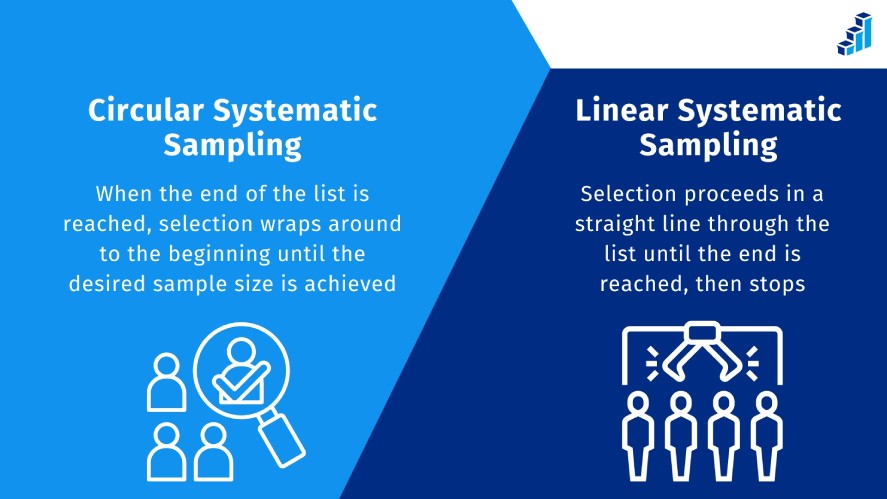
Both approaches follow the same principle. The difference lies in whether you stop at the end of the list or continue looping through until your systematic random sample is complete.
When to Use Systematic Sampling in Feedback
Systematic sampling can be a highly efficient method for collecting customer feedback, but knowing when to use it is key to getting reliable results.
This approach works best in situations where you want structure and consistency, without the complexity of fully random sampling.
Ideal Use Cases
You should consider systematic sampling when:
- Sampling a large group quickly: It’s much faster than manually choosing random participants, especially for big customer lists.
- Working with an ordered list: If your customers are organized by signup date, purchase ID, or support ticket sequence, systematic sampling ensures you cover the entire list evenly.
- Surveying after specific events: Post-purchase feedback, support follow-ups, or product usage surveys are ideal moments to apply a consistent selection pattern.
By applying systematic sampling in these scenarios, you reduce the risk of over- or under-representing certain segments while keeping your process manageable and structured.
Benefits For Customer Feedback
Systematic sampling offers several advantages over purely random sampling:
- Time efficiency: It’s quicker to select every k-th customer than to generate a fully random sample.
- Even distribution: Responses are collected evenly across the population, helping avoid clustering in one section of the customer list.
- Lower administrative burden: Minimal setup and tracking are required, which is especially helpful for recurring surveys.
Overall, systematic sampling allows businesses to collect actionable insights efficiently while maintaining representative coverage across their customer base.
Limitations and Risks of Systematic Sampling
While systematic sampling can simplify survey collection, it’s important to understand its limitations to avoid misleading results.
Using it incorrectly can introduce bias or reduce sample quality.
Pattern Bias
One key limitation of systematic sampling is the risk of pattern bias.
If your customer list has an underlying order, such as by region, purchase amount, or account type, selecting every k-th entry could unintentionally overrepresent certain groups and underrepresent others.
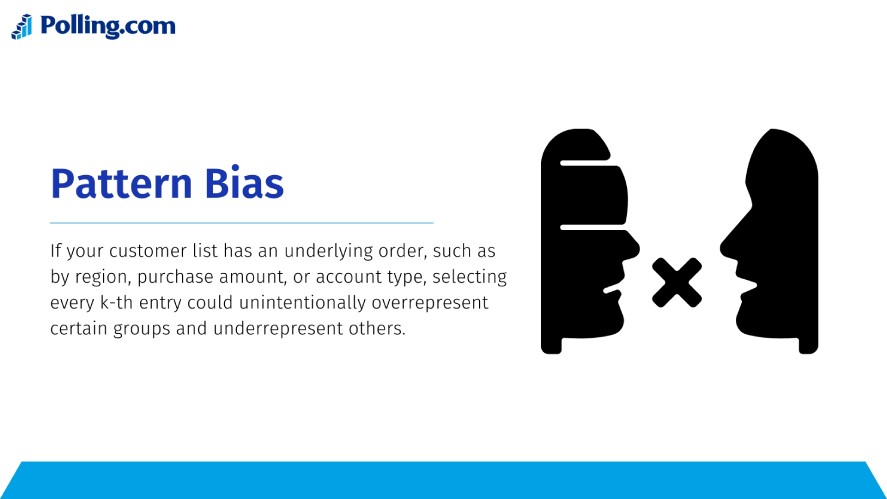
For example, if high-value customers are grouped together in your list, you might repeatedly sample similar customers while missing the diversity of the full population.
So, it’s important to check your list for such patterns before applying systematic sampling.
Requires a Full Sampling Frame
Systematic sampling depends on having a complete and accurate sampling frame. This means you need an up-to-date, fully ordered list of all potential respondents.
If the list is incomplete, outdated, or biased, the resulting sample won’t accurately reflect your customer population, which can skew survey results and lead to misleading insights.
Ensuring data quality is therefore a critical step before implementing this method.
Lack of Flexibility
Finally, systematic sampling can be less flexible than other types of sampling techniques.
Since it selects individuals at fixed intervals, it may skip adjacent or clustered entries, making it harder to ensure that specific subgroups are proportionally represented.
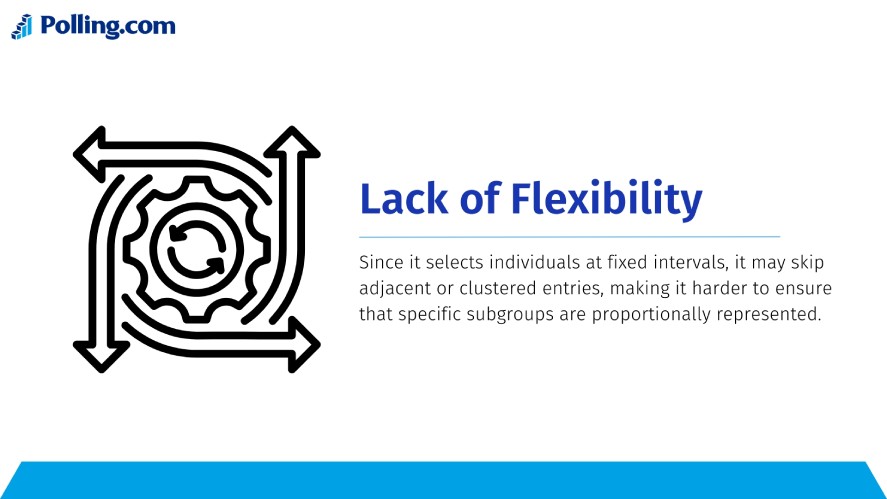
To address this, systematic sampling is often combined with stratification, which allows you to divide the population into meaningful groups and then apply the sampling method within each group.
How to Apply Systematic Sampling in Customer Feedback
Applying systematic sampling effectively ensures that your customer feedback is structured and representative.
By following a clear process, you can gather insights quickly without compromising accuracy.
Step-by-Step Setup
Here are the steps to apply systematic sampling in your customer feedback survey:
- Define your customer list: Identify the full population you want to sample. For example, all customers who purchased in the last 30 days.
- Determine your sample size (n): Decide how many responses you want to collect for meaningful insights.
- Calculate the sampling interval (k): Use the formula: k = N / n, where N is the total population. This tells you how frequently to select customers.
- Randomly choose a starting point: Pick a number between 1 and k to begin your sampling.
- Select every k-th customer: From your starting point, select every k-th individual on the list until your sample is complete.
- Distribute the survey: Send your feedback form to the selected customers via email, in-app notification, or other channels.
- Record and track responses: Monitor who responds, log the results, and prepare the data for analysis to ensure completeness and accuracy.
Read More: Survey Sample Size Calculator: Get Your Sample Estimate
Real-Life Applications
Systematic sampling can be applied in a variety of practical scenarios.
For post-purchase surveys, you might email every 10th order to gather customer satisfaction feedback. In customer support, collecting feedback from every 5th resolved ticket ensures a structured view of service quality.
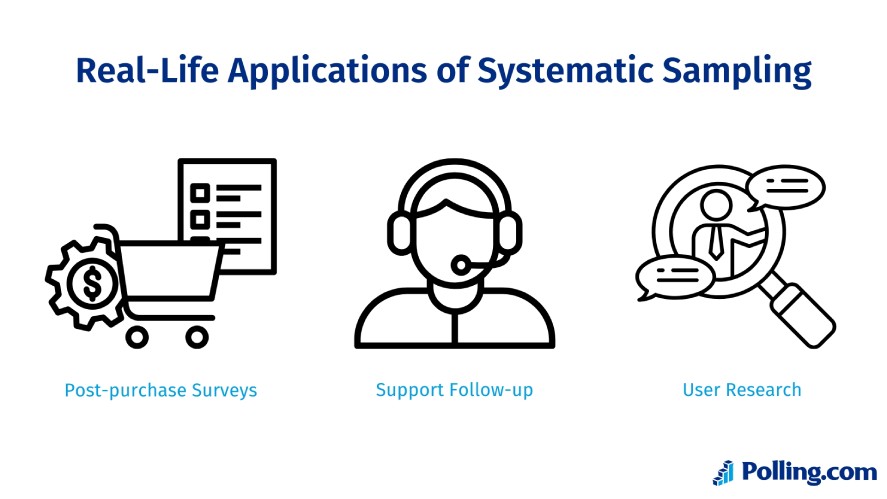
Similarly, for user research, sampling new users by signup order allows you to monitor onboarding experiences consistently over time.
These examples show how systematic sampling can streamline data collection while maintaining balanced coverage across your customer base.
Ensuring Sample Quality
Collecting feedback is only useful if your sample accurately represents your customer base.
Ensuring sample quality helps reduce bias, maintain consistency, and make your survey results reliable and actionable.
Avoiding Bias
Before you start, always inspect your customer list for any hidden patterns.
If the list is ordered in a way that could skew results, for example, grouped by region, purchase type, or customer size, systematic sampling may overrepresent certain segments.
In such cases, consider shuffling or randomizing the list before sampling to reduce bias and ensure a more representative selection.
Consider Stratified Systematic Sampling
In some situations, a simple systematic sample may not capture key subgroups.
To address this, split your population into relevant categories first, like plan type, location, or customer tier, and then apply systematic sampling within each subgroup.
This approach combines the consistency of systematic sampling with the precision of stratified sampling types and techniques, ensuring that all important segments are proportionally represented.
Addressing Nonresponse
Even with a carefully selected sample, not all participants will respond. So, predefine how you will handle nonresponses to maintain consistency.
You can either skip the nonresponding individual or replace them with the next person in line according to your interval.
Whatever method you choose, keep it consistent across your survey to avoid introducing new bias.
Comparison with Other Sampling Methods
Systematic sampling is just one approach among many in survey design, and understanding how it compares to other sampling techniques and general sampling and techniques can help you choose the best method for your customer feedback program.
Systematic vs Random Sampling
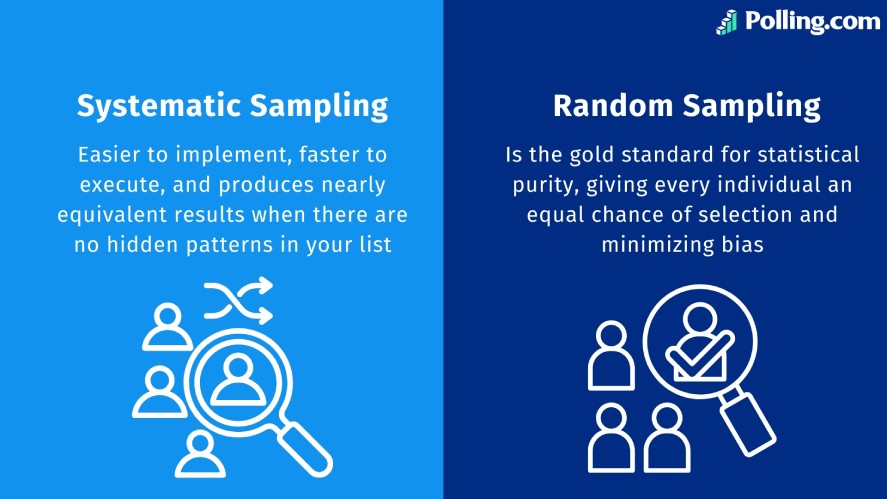
Random sampling is the gold standard for statistical purity, giving every individual an equal chance of selection and minimizing bias.
However, it can be more complex to manage, especially with large customer lists.
Systematic sampling offers a practical alternative: it’s easier to implement, faster to execute, and produces nearly equivalent results when there are no hidden patterns in your list.
For most customer feedback surveys, this trade-off between ease and statistical rigor is acceptable.
Systematic vs Stratified Sampling
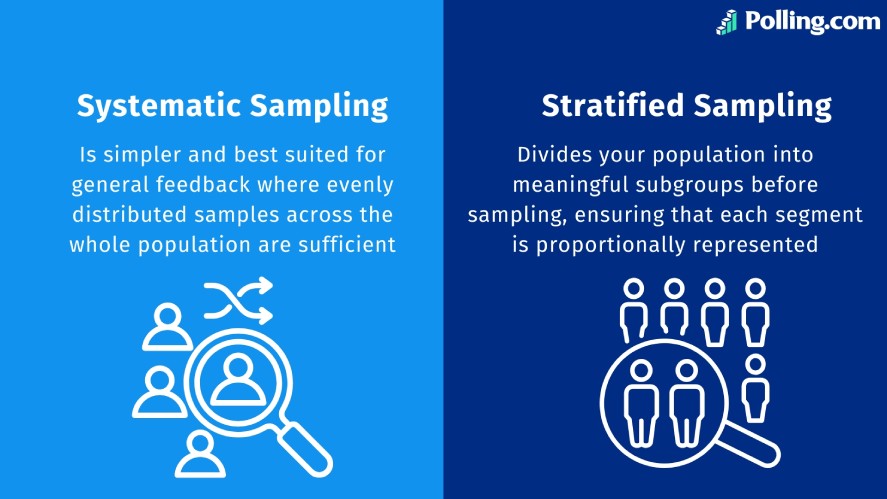
Stratified sampling divides your population into meaningful subgroups before sampling, ensuring that each segment is proportionally represented.
While this is excellent for capturing detailed insights, it adds complexity to your survey setup and management.
Systematic sampling, by contrast, is simpler and best suited for general feedback where evenly distributed samples across the whole population are sufficient.
Systematic vs Cluster Sampling
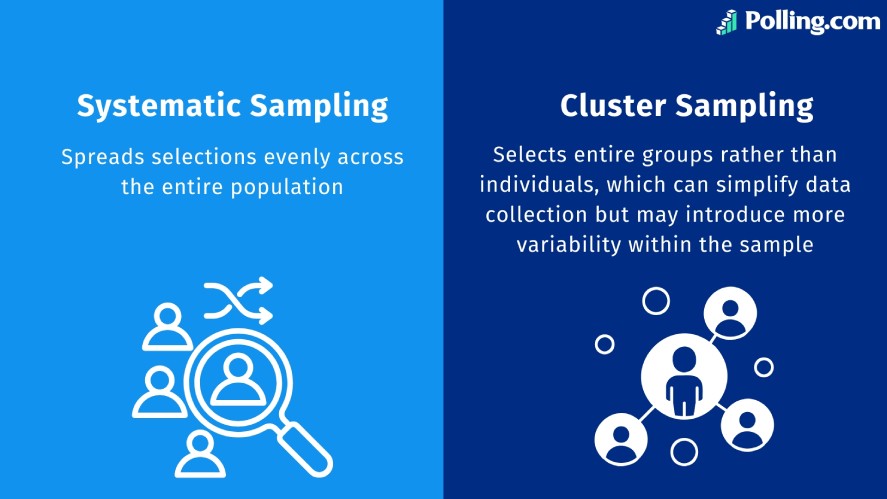
Cluster sampling selects entire groups, such as locations, store branches, or customer types, rather than individuals, which can simplify data collection but may introduce more variability within the sample.
Systematic sampling, on the other hand, spreads selections evenly across the entire population.
This method reduces the risk of overrepresenting certain clusters and providing a more balanced overview of your customer base.
Case Studies and Systematic Sampling Examples
To see systematic sampling in action, let’s explore the following systematic random sampling examples and see how different types of businesses can apply it to gather customer feedback efficiently.
Retail Example
For an example of systematic random sample, consider a retail brand surveying every 20th in-store customer to gather balanced feedback.
By sampling every 20th visitor, the company can collect a manageable and consistent set of feedback forms, ensuring that responses are evenly spread throughout the day and across different store locations.
This approach provides actionable insights while keeping the process simple and non-disruptive.
SaaS Example
A software company aiming to improve its onboarding process surveys every 15th new user who signs up.
This systematic approach ensures that feedback is collected consistently across different signup periods, helping the team identify patterns in user experience, onboarding hurdles, or areas for improvement without surveying every single user.
Support Feedback Example
A customer service team wants to measure satisfaction without overwhelming the support staff or customers.
By sending a CSAT survey to every 10th resolved ticket, the team can track trends, identify recurring issues, and improve support quality.
Systematic sampling here balances workload with consistent, actionable feedback.
Metrics, Validation & Analysis
Once your systematic sampling survey is running, tracking and validating your results is key to ensuring reliable insights.
Start by monitoring the response rate and compare it against your overall customer base demographics to spot any gaps or underrepresented segments.
Next, be aware of response bias.
For example, certain types of customers might be more likely to reply, which could skew your results.
You can validate your findings by comparing them with responses from open survey invitations or ongoing feedback channels.
If you plan to report statistically, consider estimating sampling error and calculating confidence intervals to understand the precision of your results.
These steps help ensure that the feedback you gather is both actionable and representative of your larger customer base.
Conclusion and Best Practices
Systematic sampling is a simple yet effective method for collecting customer feedback, particularly when dealing with high volumes or time-sensitive surveys.
For best results, always randomize your starting point to avoid bias, check your list for patterns that might influence the systematic sampling sample and adjust if necessary, and combine systematic sampling with stratification if you need to ensure subgroup representation.
By applying these practices, you can streamline feedback collection, maintain efficiency, and still achieve representative insights that support better business decisions.
